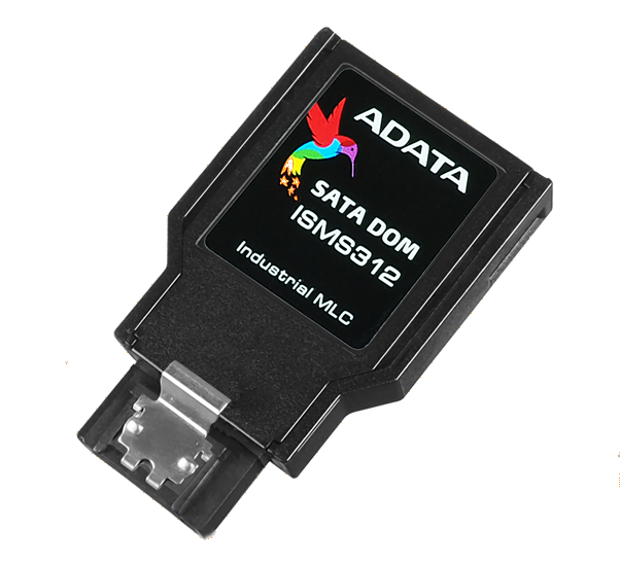ADATA Technology, a leading producer of high performance DRAM memory and NAND Flash devices, is announcing the ISMS312, its new high-performance SATA III (6Gb/s) 7-pin Disk-On-Module (DOM) solid-state drive (SSD). The ISMS312 SATA-DOM is geared toward industrial computers, embedded storage applications, medical devices and network infrastructure devices. The ISMS312 also features industrial-grade S.M.A.R.T. drive monitoring capabilities, and is customizable to most any industrial application, delivering the optimum balance between cost and performance.
ADATA’s ISMS312 utilizes high-speed MLC NAND flash to deliver superior performance and reliability. Sequential read speeds are stated as (up to) 250MB/s, with sequential write speeds of (up to) 40MB/s. ADATA’s new SATA-DOM features a miserly 1.15W of power consumption, which can also significantly extend the lifespan of the host device. The ISMS312 has an environmental operating range of from -40 degrees Celsius to +85 degrees Celsius, allowing it to still work in even the harshest of environments.
ADATA has also developed the “A+ SLC Solution,” which effectively improves the SSD’s stability, performance and lifespan by more than 3X that of a typical MLC configuration; which brings it closer to that of SLC NAND, but at a cost savings of nearly 80%. The ISMS312 is a high-quality upgrade solution for industrial applications, with the ability to deliver both performance and cost savings.
The ISMS312 SATAIII 6Gb/s Disk-On-Module features industrial-level S.M.A.R.T. drive monitoring attributes to automatically detect drive condition, including NAND flash and device status to effectively protect data. It also monitors SSD life left and wear-leveling to help prolong the SSD’s lifespan. Mean Time Between Failures (MTBF) is stated as (up to) 1 million hours.
ADATA’s ISMS312 is being offered in both horizontal and vertical configurations in the following capacity points: 8GB, 16GB and 32GB. This broad range of capacity and form factor combinations allows it to meet the widely varied needs of factory automation, embedded systems, IPC, healthcare and medical devices, networking, military and defense, surveillance and a multitude of other usage scenarios.
With the purchase of an ISMS312 SATA-DOM, ADATA includes a free download of the “ADATA SSD Toolbox,” which permits users to check their SSD’s information and health, and allows for configuration of system settings (including over-provisioning). ADATA’s superior quality, customized service, and prompt and efficient technical support make the ISMS312 an ideal and reliable solution for industrial usage applications.
 The ADATA press release announcing the ISMS312 can be viewed in its entirety here.
The ADATA press release announcing the ISMS312 can be viewed in its entirety here.
 The SSD Review The Worlds Dedicated SSD Education and Review Resource |
The SSD Review The Worlds Dedicated SSD Education and Review Resource | 

I wish these kinds of modules would be designed with budget users in mind.
Slap a simple, dramless controller, TLC flash and capacity from 32-128GB coupled with a low price. Savings on dram, materials (less plastic, pcb, metal) and controller could easily yield very low prices, so these kinds of drives would be attainable to even the most budget systems. And slap some disk caching software to go with and you’ve got yourself a seller.
If you were running a business, would you sell something for less than people were willing to pay for it? I think that’s called charity.
Thats a fair point. But people were willing to pay 150$ or even 200$ for 256GB drive not that long ago and yet some manufactures are selling that capacity for 100$ or less. I understand goal of every company is to make lots of money. But that doesn’t mean, they have to sell only the most expensive drive.
Just look at crucial. With their very agressivly priced MX and M series, those drives sell like hotcakes. Demand is literaly soo big, prices actually tend to go up, instead of down.
So yeah, i think is defenetly market for even lower priced drives. Now that more and more TLC capable solutions are popping out (marvell, SM..) and quality and volume of TLC is ramping up, there is defenetly possibility to do that.
Oh man, wouldn’t these be great for having one for each operating system? Well, for OS junkies like me, I guess. But we need at least 64GB for that, although I suppose the 32GB might work, keeping in mind that you’d want at least 50% of the drive empty for fast performance.